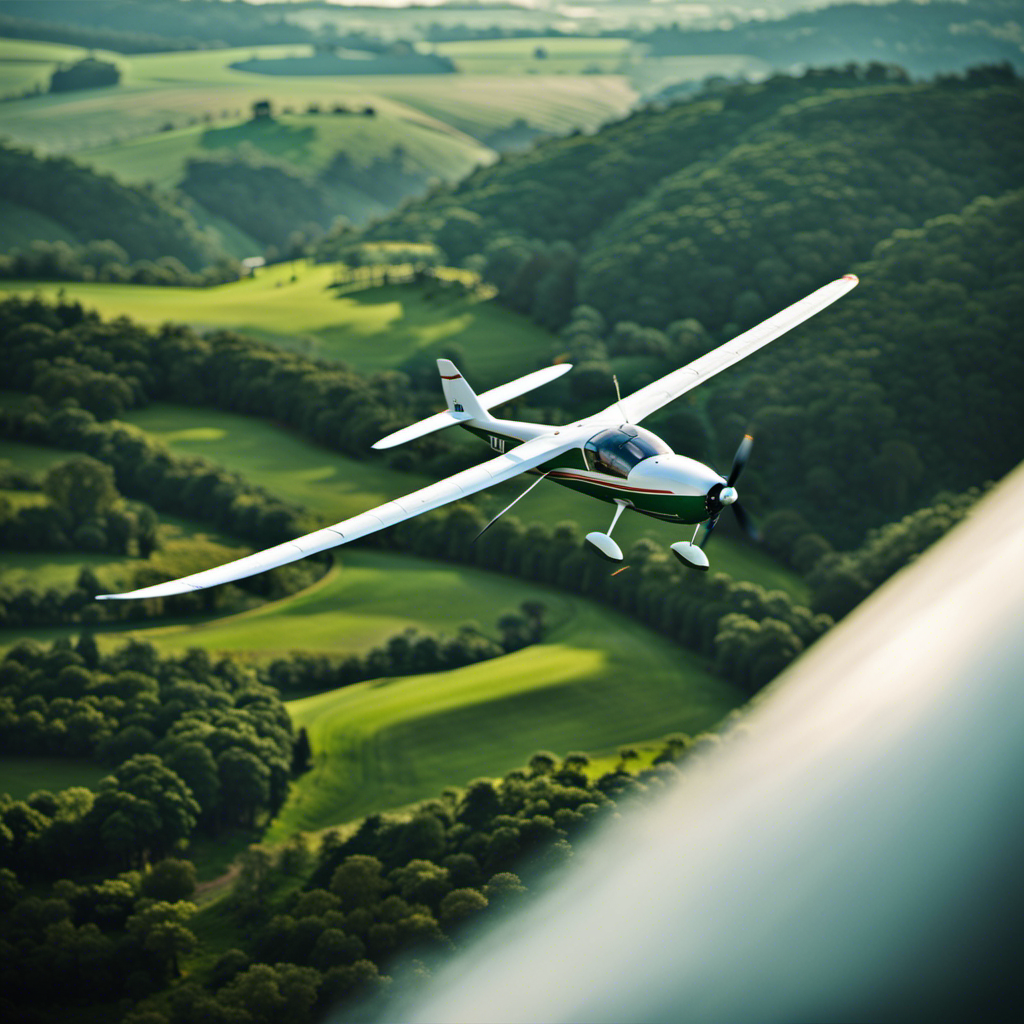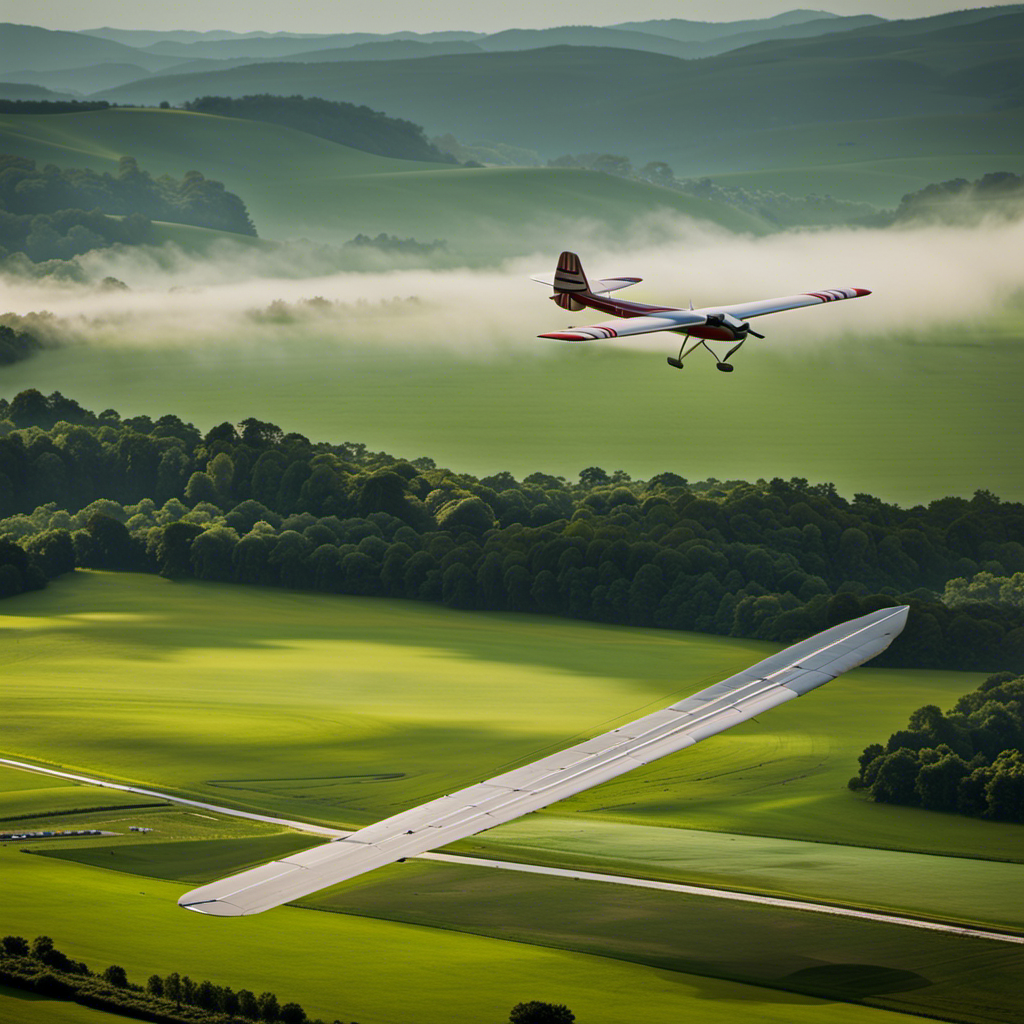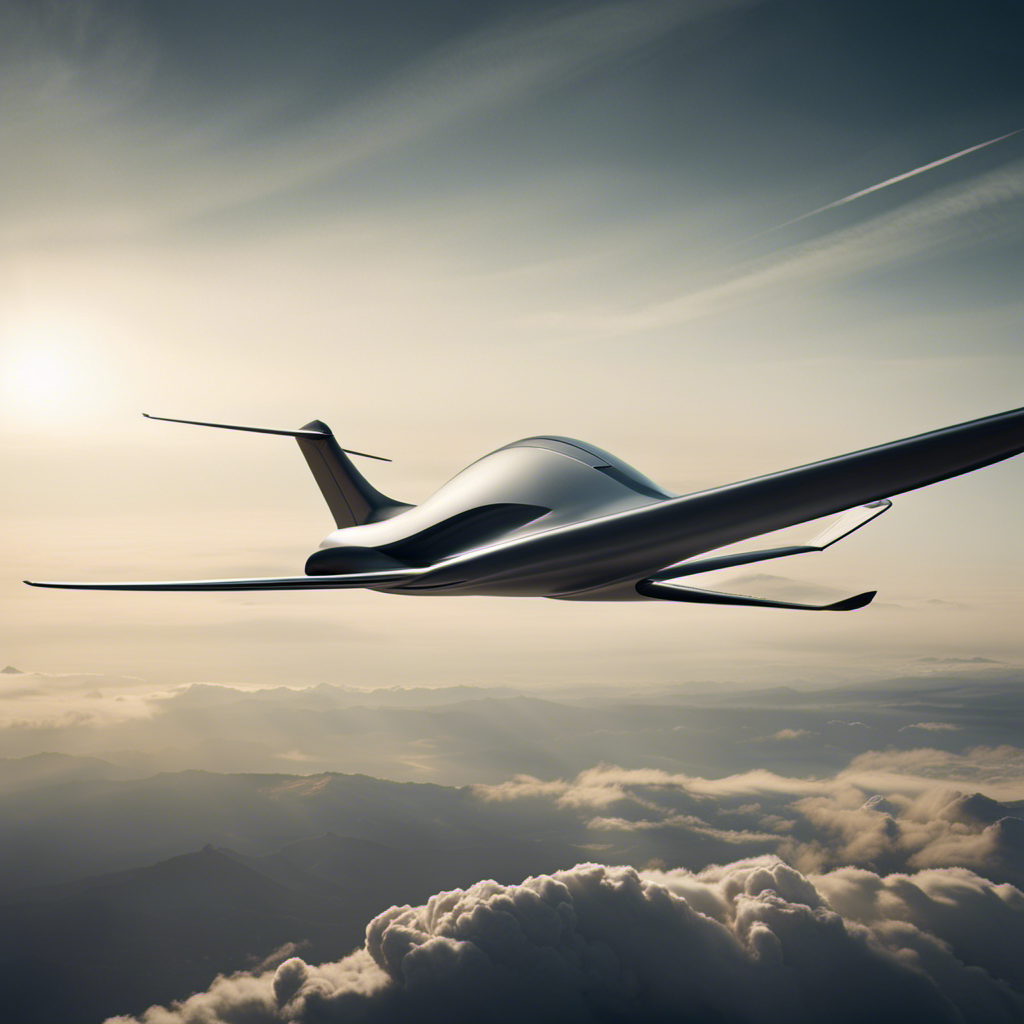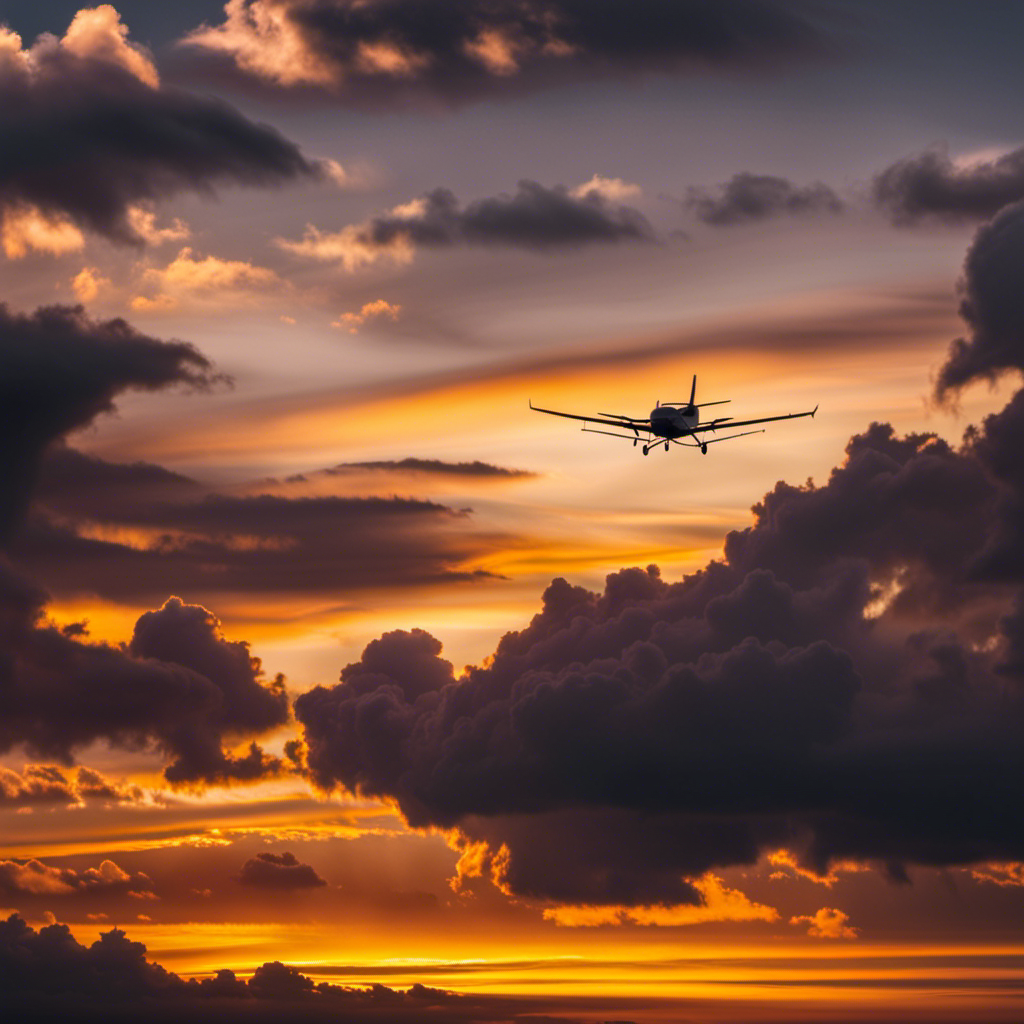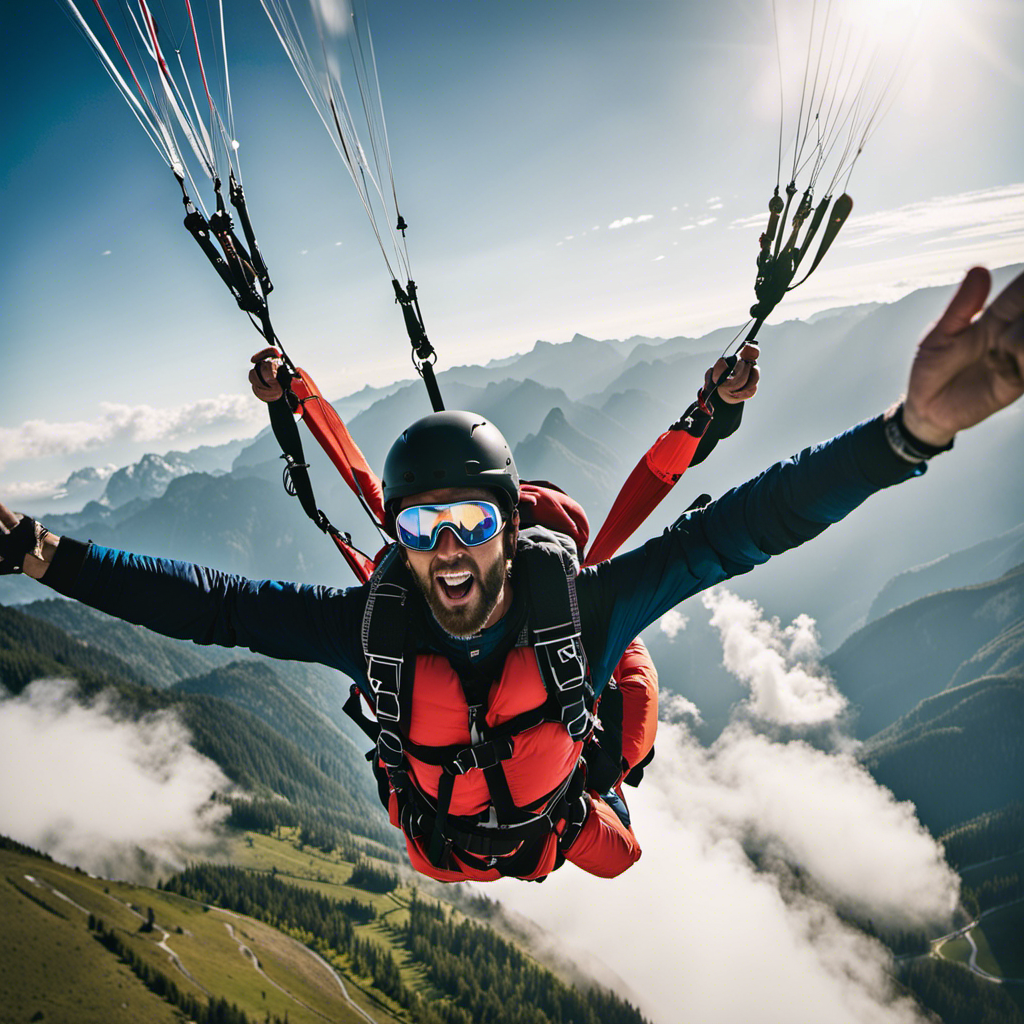As a glider pilot, I have always been fascinated by the landing process. It showcases the highest level of skill, precision, and quick decision-making.
In this in-depth guide, I will take you through the ins and outs of glider landings, from the basics to advanced techniques. We’ll delve into the key elements, such as approach, flare, and touchdown, while also exploring emergency procedures and common mistakes to avoid.
So, fasten your seatbelts and get ready to elevate your landing skills to new heights.
Key Takeaways
- Conduct thorough inspections before every flight and regularly maintain landing gear for optimal performance and safety.
- Evaluate wind conditions, adjust heading, and adjust glide path to counteract crosswinds for a successful landing.
- Timing the flare based on speed and altitude is crucial for a smooth landing, and finesse the glider onto the runway with minimal impact.
- Be prepared and equipped for unexpected situations, practice emergency landing procedures, and maintain focus and situational awareness during emergencies.
The Basics of Glider Landings
Now let’s talk about the key elements you need to know for a successful glider landing. One of the first things to consider is properly preparing your aircraft.
Before every flight, it is essential to conduct a thorough inspection to ensure that everything is in working order. This includes checking the control surfaces, verifying the integrity of the wings, and examining the landing gear. Speaking of landing gear, regular maintenance is crucial to ensure its optimal performance. This involves cleaning and lubricating the moving parts, checking for any signs of wear or damage, and ensuring that the shock absorbers are functioning correctly.
Having a well-maintained landing gear is essential for a smooth and safe landing. It provides stability and absorbs the impact of touchdown, preventing damage to the aircraft and ensuring the pilot’s safety. Neglecting landing gear maintenance can lead to unexpected failures during landing, compromising the entire operation.
Now that we have covered the importance of preparing the aircraft and maintaining the landing gear, let’s move on to the next section, which focuses on preparing for a successful landing. This involves understanding the various factors that affect the landing process and taking necessary precautions to ensure a smooth touchdown.
Preparing for a Successful Landing
To ensure a successful landing, you should start by checking your instruments and adjusting your approach accordingly. This is crucial for maintaining control and ensuring a safe touchdown. Here are some key steps to consider:
-
Confirm Altitude: Make sure you are at the appropriate altitude for landing. Use your altimeter to verify that you are descending at a safe rate.
-
Check Airspeed: Adjust your airspeed to the recommended approach speed for your glider. This will help you maintain stability and control during the landing.
-
Evaluate Wind Conditions: Assess the wind direction and speed to determine the most suitable approach path. Adjust your heading accordingly to compensate for crosswinds.
These steps will help you set the stage for a successful landing. However, it is important to be prepared for any unforeseen circumstances. Familiarize yourself with emergency procedures and be ready to implement them if necessary. This will ensure that you can handle unexpected situations and respond effectively.
Now that you have prepared for a successful landing, let’s move on to the next section: approach and final glide. Here, we will focus on the specific techniques and strategies to execute a smooth landing.
Approach and Final Glide
Make sure you evaluate wind conditions and adjust your heading accordingly during the approach and final glide. Proper approach techniques and final glide strategies are crucial for a successful glider landing. When approaching the landing area, it is important to consider the wind direction and speed to ensure a safe and smooth landing. By assessing the wind conditions, you can adjust your heading to counteract any crosswinds and maintain a stable flight path.
To help you understand the different approach techniques and final glide strategies, I have provided a table below:
| Approach Techniques | Final Glide Strategies | Wind Conditions |
|---|---|---|
| Straight-In Approach | Minimum Sink Approach | Headwind |
| S-Curve Approach | Aerotow Approach | Tailwind |
| Side-Slip Approach | Thermal Approach | Crosswind |
The straight-in approach is the most common method, where you fly directly towards the landing area while adjusting your glide path. The S-curve approach involves making a series of gentle turns to lose altitude gradually. Side-slip approach is useful in crosswind conditions, where you intentionally create drag on one wing to counteract the wind drift.
Now that you have learned about approach and final glide techniques, let’s move on to the next section about flare and touchdown, where we will discuss the precise movements required for a smooth landing.
Flare and Touchdown
When it comes to the art of glider landing, two key points require precision and skill. The first is timing the flare, which is crucial for reducing the descent rate and achieving a smooth landing. The flare involves raising the glider’s nose at the right moment. The second point is executing a smooth touchdown. This involves maintaining control and gently touching down on the runway, minimizing any bouncing or excessive roll.
Timing the Flare
Remember, you’ll want to gauge the timing of the flare based on your speed and altitude. Timing techniques are crucial in mastering the flare, as it is the moment when you transition from descending to level flight just before touchdown. To help you understand the importance of timing, let’s take a look at the table below:
| Speed (knots) | Altitude (feet) | Flare Timing |
|---|---|---|
| 50 | 500 | 2 seconds |
| 60 | 600 | 2.5 seconds |
| 70 | 700 | 3 seconds |
| 80 | 800 | 3.5 seconds |
| 90 | 900 | 4 seconds |
As you can see, the higher your speed and altitude, the more time you’ll need to initiate the flare. It’s essential to practice these timing techniques to ensure a smooth touchdown. Now, let’s move on to executing a smooth touchdown, where precision and finesse are key.
Executing a Smooth Touchdown
After mastering the art of timing the flare, the next crucial step in executing a smooth glider landing is the touchdown itself.
As the glider descends closer to the ground, it is vital to maintain precise control and accuracy to ensure a safe landing.
To achieve this, I employ a combination of emergency landing techniques that have been honed through countless hours of training and experience.
These techniques involve adjusting the glider’s pitch and angle of attack to control the rate of descent and glide path.
By carefully monitoring airspeed and incorporating subtle control inputs, I can finesse the glider onto the runway with minimal impact and maximum control.
This delicate process requires focus, precision, and the ability to adapt to changing conditions.
With the touchdown complete, it is time to transition seamlessly into the next phase of the emergency landing procedures.
Emergency Landing Procedures
When faced with unexpected situations during a flight, it is crucial to be prepared and equipped with the necessary emergency landing techniques.
As a pilot, I understand the importance of remaining calm and focused in such situations to ensure the safety of both myself and any passengers on board.
In this discussion, I will explore the procedures and strategies for dealing with unexpected situations and executing emergency landings with precision and effectiveness.
Dealing with Unexpected Situations
If you encounter unexpected situations while glider landing, you’ll need to remain calm and think quickly to ensure a safe outcome. Being prepared for potential challenges is crucial. Here are some key points to keep in mind:
-
Wind shear: Sudden changes in wind speed or direction can create hazardous conditions during landing. It’s important to anticipate and react to these changes by adjusting your approach and control inputs accordingly.
-
Equipment failures: In the event of equipment malfunctions, such as aileron or elevator failure, it is essential to know how to compensate for the loss of control. Understanding the aerodynamics of your glider and practicing emergency procedures will help you stay in control and make the right decisions.
-
Stay focused: Unexpected situations can be stressful, but it’s important to stay focused and maintain situational awareness. Keep your eyes on the landing area and be ready to adapt your landing strategy if needed.
-
Communicate: If you encounter unexpected situations, don’t hesitate to communicate with other gliders or the ground crew. They can provide guidance or assistance during the landing process.
Emergency Landing Techniques
To effectively handle emergency situations during glider landings, you should familiarize yourself with various landing techniques and practice them regularly. These techniques will allow you to react calmly and confidently when faced with unexpected challenges in the air.
Two common emergency scenarios that you may encounter are parachute deployment and landing gear malfunction. In the event of a parachute deployment, it is crucial to maintain control of the glider and avoid any sudden movements that could jeopardize your safety.
When faced with a landing gear malfunction, your priority should be to establish a stable glide and assess the conditions for a safe landing. Remember, preparation is key, so ensure that you are well-versed in these emergency procedures to handle any situation that may arise.
Now, let’s delve into the next section on crosswind landings.
Crosswind Landings
Crosswind landings can be challenging for pilots due to the strong wind blowing perpendicular to the runway. As a pilot, mastering crosswind techniques is crucial to ensure a safe and smooth landing. One important aspect to consider is maintaining the landing gear in optimal condition. The landing gear plays a vital role in absorbing the forces generated during a crosswind landing, so regular maintenance and inspections are essential.
To effectively handle crosswind landings, pilots must utilize proper technique. During approach, it is important to establish a crab angle to counteract the wind’s effect. As the aircraft approaches the runway threshold, the pilot should transition from the crab angle to a wing-low technique. This involves aligning the aircraft’s longitudinal axis with the runway centerline while simultaneously lowering the upwind wing to counteract the crosswind force. This technique allows the aircraft to maintain a straight path along the runway during touchdown.
Mastering crosswind landings sets the foundation for more advanced landing techniques. Transitioning smoothly from a crosswind landing to advanced techniques, such as short field landings or precision landings, requires the pilot to maintain precise control and make quick adjustments based on the prevailing wind conditions. These advanced techniques further enhance the pilot’s ability to handle various landing scenarios, ensuring a safe and efficient landing every time.
Advanced Landing Techniques
When it comes to advanced landing techniques in glider flying, two key skills that every pilot should master are short field landings and precision spot landings.
Short field landings require precise control and technique to safely land in a limited space, such as a small runway or an unprepared field.
Precision spot landings, on the other hand, demand utmost accuracy in touching down at a specific point, often marked by a designated target or landing zone.
These techniques can greatly enhance a pilot’s ability to safely and efficiently land a glider in challenging conditions.
Short Field Landings
Remember, you’ll need to adjust your approach speed and descent angle for short field landings. Short field takeoffs and landings require precision and careful execution. Here are four key considerations for successful short field landings:
-
Landing Gear Maintenance: Ensure that your landing gear is in excellent condition before attempting a short field landing. Regular inspections and maintenance are crucial for optimal performance and safety.
-
Approach Speed: Reduce your approach speed to allow for a shorter landing distance. This will require accurate control inputs and a keen understanding of your glider’s performance capabilities.
-
Descent Angle: Maintain a steeper descent angle to minimize the ground roll. This will allow you to touch down closer to your desired spot and reduce the distance required to come to a complete stop.
-
Flare Technique: Use a smooth and controlled flare to bleed off excess airspeed just before touchdown. This will help you achieve a soft and precise landing.
With these techniques mastered, you can seamlessly transition into the subsequent section on precision spot landings.
Precision Spot Landings
After mastering the technique of short field landings, I was ready to take on a more advanced aspect of glider landings: precision spot landings. This skill is essential for glider pilots who wish to compete in landing competitions.
Precision spot landings require the pilot to touch down on a specific target, usually marked by a small circle on the ground. Achieving a precise landing spot not only demonstrates the pilot’s skill and control, but also plays a crucial role in maximizing safety during landings. It involves carefully judging the wind, adjusting the glide path, and making precise control inputs to ensure a smooth touchdown within the designated area.
Now, let’s explore some common landing mistakes and how to avoid them…
Common Landing Mistakes and How to Avoid Them
To avoid common landing mistakes, you should focus on maintaining a steady approach speed. Proper technique plays a crucial role in achieving a smooth and safe landing. Many pilots make the same errors, often due to lack of experience or poor training. Let’s take a closer look at some of these common mistakes and how to avoid them:
| Common Landing Mistakes | How to Avoid Them |
|---|---|
| Coming in too fast | Use the recommended approach speed for your glider. It ensures better control and a safer touchdown. |
| Flaring too early | Wait until you are just above the ground before starting the flare. This helps reduce the risk of ballooning or stalling. |
| Poor alignment | Maintain a proper glide path and aim for the designated landing spot. Aligning yourself correctly ensures a precise touchdown. |
Tips for Improving Your Landing Skills
When it comes to improving landing skills, two key points to consider are practicing regularly and seeking guidance from experienced pilots.
Regular practice allows for the development of muscle memory and fine-tuning of techniques, which can greatly enhance landing proficiency.
Additionally, seeking guidance from experienced pilots provides valuable insights and tips based on their own experiences, helping to refine landing approaches and techniques even further.
Practice Regularly
It’s important to regularly practice glider landings to improve your skills. Regular practice allows you to develop muscle memory, which is crucial for executing precise and controlled landings. By consistently repeating the landing process, your muscles become familiar with the necessary movements and timing required for a successful touchdown. This muscle memory enables you to make subtle adjustments and corrections during the landing phase without consciously thinking about them. It becomes second nature.
However, while regular practice is beneficial, it’s equally important to seek guidance from experienced pilots. Their knowledge and expertise can provide valuable insights and help you refine your technique. Learning from those who have mastered the art of glider landing will further enhance your skills and ensure a safe and smooth touchdown every time.
Seek Guidance from Experienced Pilots
Learning from experienced pilots is essential for refining your glider landing technique and gaining valuable insights. These seasoned aviators have accumulated a wealth of knowledge and can provide guidance that can significantly enhance your skills. Their expertise can help you understand the intricacies of different landing techniques, allowing you to adapt to various conditions and improve your overall performance.
To highlight the importance of seeking guidance from experienced pilots, I have compiled the following table, which showcases the diverse landing techniques they employ:
| Technique | Description | Advantages |
|---|---|---|
| Slip | Controlled side-slip to increase drag | Shortens the approach and improves accuracy |
| Crab | Aligning the aircraft with the wind | Reduces drift and ensures a smooth touchdown |
| Flare | Gradual reduction of descent rate | Provides a soft touchdown and minimizes bounce |
| Touchdown Point | Selecting the ideal spot for touchdown | Maximizes safety and minimizes rollout distance |
| Go-around | Aborting the landing and performing a climb | Ensures safety in case of unstable approach |
By learning from these experienced pilots, you can adopt these techniques and become a more skilled glider pilot. Understanding their advantages and when to utilize them will greatly enhance your landing proficiency.
Transitioning into the subsequent section about safety considerations and resources for glider landing, it is crucial to complement your landing technique with a thorough understanding of safety protocols and available resources.
Safety Considerations and Resources for Glider Landing
Make sure you check out the safety considerations and resources available for glider landing. Safety training is essential to ensure a successful and safe landing. As a glider pilot, I understand the importance of being well-prepared and taking the necessary precautions. Before attempting any landing, it is crucial to undergo proper safety training, which includes understanding the glider’s limitations and operating procedures.
One key aspect of glider safety is maintaining the landing gear. Regular maintenance and inspections are vital to ensure the gear’s functionality and reliability. As a pilot, I always make it a priority to inspect the landing gear before every flight. This includes checking for any signs of wear and tear, ensuring that all components are properly secured, and verifying that the gear operates smoothly.
In addition to safety training and landing gear maintenance, there are several resources available to aid in safe glider landings. These resources include instructional materials, such as manuals and videos, which provide detailed information on landing techniques and best practices. Additionally, seeking guidance from experienced glider pilots and instructors can greatly enhance one’s understanding of safe landing procedures.
Frequently Asked Questions
What is the best type of glider to use for landing?
The best type of glider to use for landing is a high-performance glider with excellent maneuverability and controllability. It should have a sturdy construction, reliable braking system, and efficient stall characteristics to ensure a safe and smooth landing.
How do I handle unexpected wind gusts during the landing phase?
To handle unexpected wind gusts during landing, it’s crucial to maintain control and make precise adjustments. By anticipating crosswinds, I can use aileron and rudder inputs to counteract drift and maintain alignment with the runway, improving landing precision.
Are there any specific techniques for landing on different types of terrain?
When landing on different types of terrain, specific techniques are required. For rocky terrain, maintaining a steady descent rate is crucial to avoid damage. On grassy surfaces, a gentle touchdown is needed to prevent the glider from sinking into the ground.
What are some common mistakes pilots make during glider landings?
Common mistakes during glider landings include misjudging approach speed, failing to maintain proper glide path, and not using appropriate control inputs. To avoid these errors, pilots can follow tips and tricks such as practicing landings, maintaining situational awareness, and utilizing proper landing techniques.
Are there any resources available for further training and improvement in glider landing skills?
There are numerous resources available for further training and improvement in glider landing skills. From online tutorials to flight simulators, these resources provide technical and detailed guidance to enhance your abilities.
Conclusion
In conclusion, mastering the art of glider landing requires a combination of skill, knowledge, and practice. By understanding the basics of glider landings and preparing for a successful landing, pilots can ensure a safe and smooth touchdown.
It is interesting to note that according to a study conducted by the Glider Pilots Association, approximately 80% of glider accidents occur during the landing phase. This statistic highlights the importance of honing one’s landing skills and being well-versed in emergency landing procedures.
Remember, a successful glider landing is not only about skill, but also about prioritizing safety at all times.
With a heart that soars as high as the skies, Aria, affectionately known as “Skylark,” is the driving force behind Soaring Skyways. Her journey into the gliding world began as a young dreamer gazing up at the soaring birds, yearning to experience the weightlessness and freedom they embodied. With years of experience both in the cockpit and behind the scenes, Aria’s commitment to the gliding community is unwavering.
